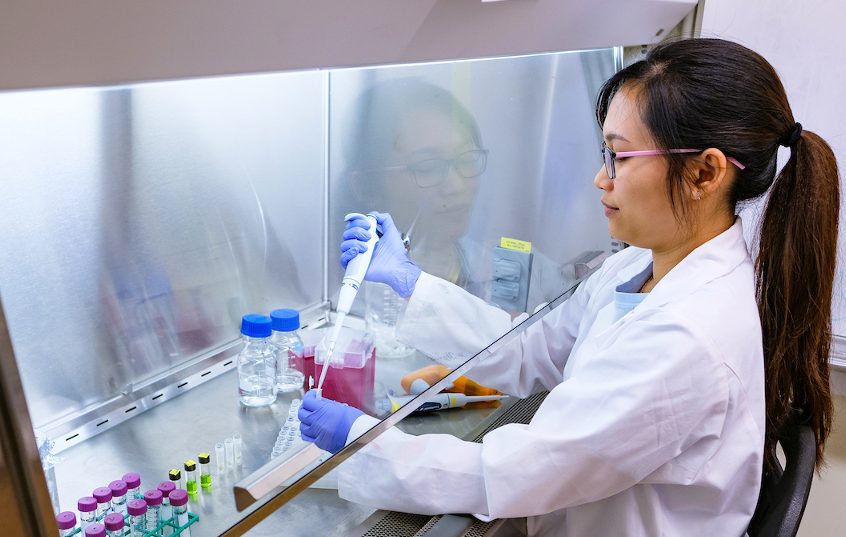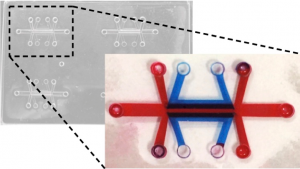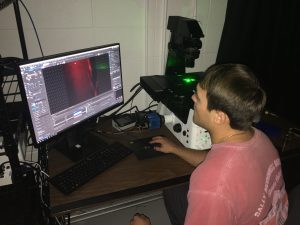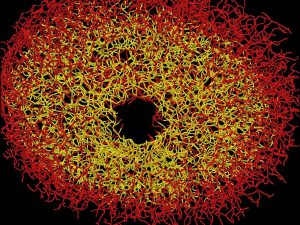Biomaterials and Drug Delivery
 The field of biomaterials focuses on design of materials that integrate with living tissues in a way that diagnoses, treats, replaces, or augments tissue function. Drug Delivery involves the design of materials that improve the performance of pharmaceutics by maximizing on-target therapeutic effects and limiting toxicity-causing side-effects. Areas of Biomaterials and Drug Delivery include: tissue engineering/regenerative medicine, orthopedics, medical implants, biosensors, controlled drug release, nanomedicine, targeted and stimuli-responsive delivery, and immunomodulation. These interdisciplinary fields are rapidly growing and evolving in response to new innovations in biotechnology and the clinical need for “smarter” therapies.
The field of biomaterials focuses on design of materials that integrate with living tissues in a way that diagnoses, treats, replaces, or augments tissue function. Drug Delivery involves the design of materials that improve the performance of pharmaceutics by maximizing on-target therapeutic effects and limiting toxicity-causing side-effects. Areas of Biomaterials and Drug Delivery include: tissue engineering/regenerative medicine, orthopedics, medical implants, biosensors, controlled drug release, nanomedicine, targeted and stimuli-responsive delivery, and immunomodulation. These interdisciplinary fields are rapidly growing and evolving in response to new innovations in biotechnology and the clinical need for “smarter” therapies.
Faculty
Adam Smith: Smith Lab
Thomas Werfel: Interdisciplinary NanoBioSciences Lab
Biomedical Microdevices
 The biomedical microdevices area leverages microscale structures and phenomena to create novel instrumentation for research in biology and medicine. Microscale phenomena give researchers a new set of tools for performing experiments that are either impossible or impractical with traditional technology. For example, researchers in the Biomedical Engineering Department at the University of Mississippi use microdevices to perform high throughput screening of drug candidates using only picoliters per sample and create complex oxygen landscapes within cell cultures.
The biomedical microdevices area leverages microscale structures and phenomena to create novel instrumentation for research in biology and medicine. Microscale phenomena give researchers a new set of tools for performing experiments that are either impossible or impractical with traditional technology. For example, researchers in the Biomedical Engineering Department at the University of Mississippi use microdevices to perform high throughput screening of drug candidates using only picoliters per sample and create complex oxygen landscapes within cell cultures.
Faculty
Glenn Walker: Walker Lab
Molecular Biophysics
 Molecular Biophysics is a rapidly evolving interdisciplinary area of research at the interface of biology, chemistry, physics, and engineering. We seek to understand the mechanics of biology from the single molecule to complex system levels, such as how biomolecules are made and how different parts of a cell move and function. Using novel approaches to better understand life at the molecular level will be pivotal in discovering the mechanisms of disease and thus developing more targeted therapeutics. Researchers at the University of Mississippi investigate the biophysics of cytoskeletal hierarchy (systems that include molecular motors, proteins, microtubules, actin, etc.) and the implications of their synergy in vital life processes such as cell division and motility using a biophysical technique called optical tweezers.
Molecular Biophysics is a rapidly evolving interdisciplinary area of research at the interface of biology, chemistry, physics, and engineering. We seek to understand the mechanics of biology from the single molecule to complex system levels, such as how biomolecules are made and how different parts of a cell move and function. Using novel approaches to better understand life at the molecular level will be pivotal in discovering the mechanisms of disease and thus developing more targeted therapeutics. Researchers at the University of Mississippi investigate the biophysics of cytoskeletal hierarchy (systems that include molecular motors, proteins, microtubules, actin, etc.) and the implications of their synergy in vital life processes such as cell division and motility using a biophysical technique called optical tweezers.
Faculty
Nikki Reinemann: Molecular Biophysics and Engineering Lab
Ocular and Neuro-Biomechanics
 Biomechanics is simply the study of mechanical laws relating to the movement or structure of living organisms. Neuro-Biomechanics is an attempt to understand how muscles, sense organs, motor pattern generators, and the brain interact to produce coordinated movement, not only in complex terrain but also when confronted with unexpected perturbations. For example, research in Neuro-Biomechanics aims to characterize human pathologies which adversely impact the ability to walk or maintain postural stability.
Biomechanics is simply the study of mechanical laws relating to the movement or structure of living organisms. Neuro-Biomechanics is an attempt to understand how muscles, sense organs, motor pattern generators, and the brain interact to produce coordinated movement, not only in complex terrain but also when confronted with unexpected perturbations. For example, research in Neuro-Biomechanics aims to characterize human pathologies which adversely impact the ability to walk or maintain postural stability.
Vision is not just about what we see, but also how our brain comprehends what we see. Visual impairment and dysfunction can be caused by diseases and injuries that affect the eye, the brain, or the optic nerve that connects them. Biomechanics play a significant role in these conditions. For example, glaucoma, a chronic and progressive eye disease, occurs when elevated intraocular pressure damages the optic nerve, leading to vision loss. Similarly, traumatic brain injury can lead to visual impairment through biomechanical forces that damage the brain areas responsible for visual processing and perception, even in the absence of direct eye damage. Our mission is to expedite the creation of innovative prevention methods, diagnostic tools, and treatment options to combat visual challenges.
Faculty
Dwight Waddell: Waddell Lab
Yi (Jason) Hua: The Vision Laboratory